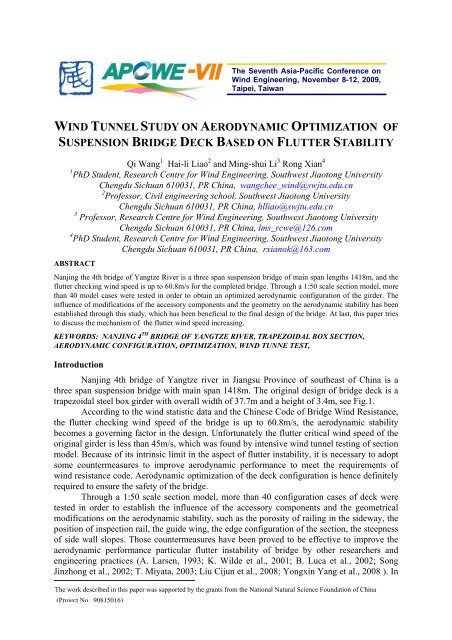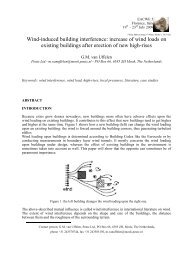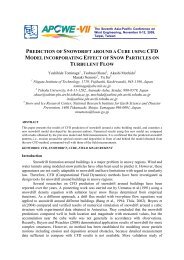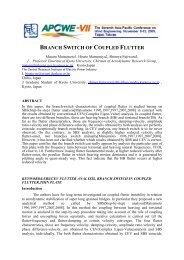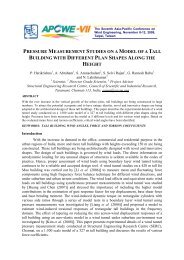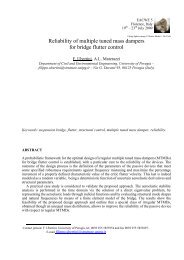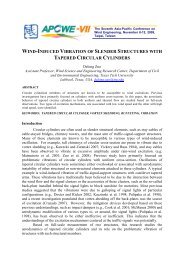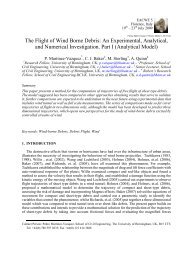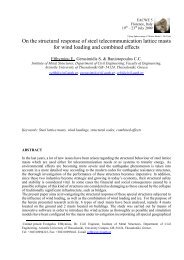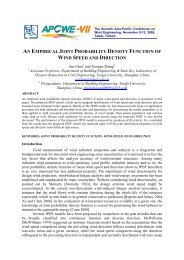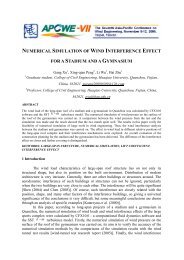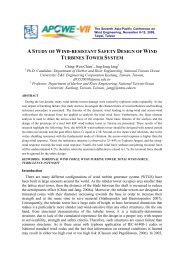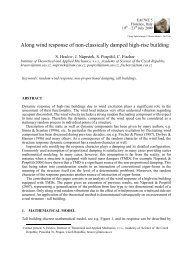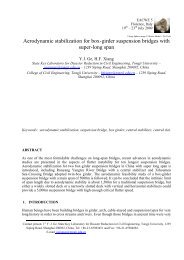wind tunnel study on aerodynamic optimization of suspension ...
wind tunnel study on aerodynamic optimization of suspension ...
wind tunnel study on aerodynamic optimization of suspension ...
Create successful ePaper yourself
Turn your PDF publications into a flip-book with our unique Google optimized e-Paper software.
The Seventh Asia-Pacific C<strong>on</strong>ference <strong>on</strong><br />
Wind Engineering, November 8-12, 2009,<br />
Taipei, Taiwan<br />
WIND TUNNEL STUDY ON AERODYNAMIC OPTIMIZATION OF<br />
SUSPENSION BRIDGE DECK BASED ON FLUTTER STABILITY<br />
Qi Wang 1 Hai-li Liao 2 and Ming-shui Li 3 R<strong>on</strong>g Xian 4<br />
1 PhD Student, Research Centre for Wind Engineering, Southwest Jiaot<strong>on</strong>g University<br />
Chengdu Sichuan 610031, PR China, wangchee_<str<strong>on</strong>g>wind</str<strong>on</strong>g>@swjtu.edu.cn<br />
2 Pr<strong>of</strong>essor, Civil engineering school, Southwest Jiaot<strong>on</strong>g University<br />
Chengdu Sichuan 610031, PR China, hlliao@swjtu.edu.cn<br />
3 Pr<strong>of</strong>essor, Research Centre for Wind Engineering, Southwest Jiaot<strong>on</strong>g University<br />
Chengdu Sichuan 610031, PR China, lms_rcwe@126.com<br />
4 PhD Student, Research Centre for Wind Engineering, Southwest Jiaot<strong>on</strong>g University<br />
Chengdu Sichuan 610031, PR China, rxianok@163.com<br />
ABSTRACT<br />
Nanjing the 4th bridge <strong>of</strong> Yangtze River is a three span suspensi<strong>on</strong> bridge <strong>of</strong> main span lengths 1418m, and the<br />
flutter checking <str<strong>on</strong>g>wind</str<strong>on</strong>g> speed is up to 60.8m/s for the completed bridge. Through a 1:50 scale secti<strong>on</strong> model, more<br />
than 40 model cases were tested in order to obtain an optimized <strong>aerodynamic</strong> c<strong>on</strong>figurati<strong>on</strong> <strong>of</strong> the girder. The<br />
influence <strong>of</strong> modificati<strong>on</strong>s <strong>of</strong> the accessory comp<strong>on</strong>ents and the geometry <strong>on</strong> the <strong>aerodynamic</strong> stability has been<br />
established through this <str<strong>on</strong>g>study</str<strong>on</strong>g>, which has been beneficial to the final design <strong>of</strong> the bridge. At last, this paper tries<br />
to discuss the mechanism <strong>of</strong> the flutter <str<strong>on</strong>g>wind</str<strong>on</strong>g> speed increasing.<br />
KEYWORDS: NANJING 4 TH BRIDGE OF YANGTZE RIVER, TRAPEZOIDAL BOX SECTION,<br />
AERODYNAMIC CONFIGURATION, OPTIMIZATION, WIND TUNNE TEST,<br />
Introducti<strong>on</strong><br />
Nanjing 4th bridge <strong>of</strong> Yangtze river in Jiangsu Province <strong>of</strong> southeast <strong>of</strong> China is a<br />
three span suspensi<strong>on</strong> bridge with main span 1418m. The original design <strong>of</strong> bridge deck is a<br />
trapezoidal steel box girder with overall width <strong>of</strong> 37.7m and a height <strong>of</strong> 3.4m, see Fig.1.<br />
According to the <str<strong>on</strong>g>wind</str<strong>on</strong>g> statistic data and the Chinese Code <strong>of</strong> Bridge Wind Resistance,<br />
the flutter checking <str<strong>on</strong>g>wind</str<strong>on</strong>g> speed <strong>of</strong> the bridge is up to 60.8m/s, the <strong>aerodynamic</strong> stability<br />
becomes a governing factor in the design. Unfortunately the flutter critical <str<strong>on</strong>g>wind</str<strong>on</strong>g> speed <strong>of</strong> the<br />
original girder is less than 45m/s, which was found by intensive <str<strong>on</strong>g>wind</str<strong>on</strong>g> <str<strong>on</strong>g>tunnel</str<strong>on</strong>g> testing <strong>of</strong> secti<strong>on</strong><br />
model. Because <strong>of</strong> its intrinsic limit in the aspect <strong>of</strong> flutter instability, it is necessary to adopt<br />
some countermeasures to improve <strong>aerodynamic</strong> performance to meet the requirements <strong>of</strong><br />
<str<strong>on</strong>g>wind</str<strong>on</strong>g> resistance code. Aerodynamic optimizati<strong>on</strong> <strong>of</strong> the deck c<strong>on</strong>figurati<strong>on</strong> is hence definitely<br />
required to ensure the safety <strong>of</strong> the bridge.<br />
Through a 1:50 scale secti<strong>on</strong> model, more than 40 c<strong>on</strong>figurati<strong>on</strong> cases <strong>of</strong> deck were<br />
tested in order to establish the influence <strong>of</strong> the accessory comp<strong>on</strong>ents and the geometrical<br />
modificati<strong>on</strong>s <strong>on</strong> the <strong>aerodynamic</strong> stability, such as the porosity <strong>of</strong> railing in the sideway, the<br />
positi<strong>on</strong> <strong>of</strong> inspecti<strong>on</strong> rail, the guide wing, the edge c<strong>on</strong>figurati<strong>on</strong> <strong>of</strong> the secti<strong>on</strong>, the steepness<br />
<strong>of</strong> side wall slopes. Those countermeasures have been proved to be effective to improve the<br />
<strong>aerodynamic</strong> performance particular flutter instability <strong>of</strong> bridge by other researchers and<br />
engineering practices (A. Larsen, 1993; K. Wilde et al., 2001; B. Luca et al., 2002; S<strong>on</strong>g<br />
Jinzh<strong>on</strong>g et al., 2002; T. Miyata, 2003; Liu Cijun et al., 2008; Y<strong>on</strong>gxin Yang et al., 2008 ). In<br />
The work described in this paper was supported by the grants from the Nati<strong>on</strong>al Natural Science Foundati<strong>on</strong> <strong>of</strong> China<br />
(Project No. 90815016)
The Seventh Asia-Pacific C<strong>on</strong>ference <strong>on</strong> Wind Engineering, November 8-12, 2009, Taipei, Taiwan<br />
this paper their sensitivity relative to <strong>aerodynamic</strong> stability were investigated through a series<br />
<strong>of</strong> secti<strong>on</strong> model <str<strong>on</strong>g>wind</str<strong>on</strong>g> <str<strong>on</strong>g>tunnel</str<strong>on</strong>g> testing. The results has benefited for the final design <strong>of</strong> the<br />
bridge, and other l<strong>on</strong>g span bridges.<br />
Figure 1: Outline <strong>of</strong> Nanjing Yangtze 4th Bridge<br />
The Influence <strong>of</strong> Railing <strong>on</strong> Flutter Critical Wind Speed<br />
In order to examine the influence <strong>of</strong> the different railing and its positi<strong>on</strong> <strong>on</strong> the critical<br />
<str<strong>on</strong>g>wind</str<strong>on</strong>g> speed, two kinds <strong>of</strong> railing with porosity 90% and 60%, three locati<strong>on</strong>s <strong>of</strong> railing <strong>on</strong><br />
deck, <strong>on</strong>e is <strong>on</strong> the edge (the original design), the others are 5mm (prototype 250mm) and<br />
10mm (prototype 500mm) from the sideway edge, are chosen to be tested. The results are<br />
given in table 1. It is found that higher <strong>aerodynamic</strong> stability for the railing with higher<br />
porosity comparing to the lower <strong>on</strong>e. This similar finding was also reported by Allan Larsen<br />
in the <strong>aerodynamic</strong> design <strong>of</strong> Great belt East Bridge (A. Larsen, 1993), and other researchers<br />
(B. Luca et al., 2002; T. Miyata, 2003; Liu Cijun et al., 2008). Comparing to the secti<strong>on</strong><br />
c<strong>on</strong>figurati<strong>on</strong> <strong>of</strong> old Tacoma Bridge deck, see fig.2, the low porosity <strong>of</strong> railing has made the<br />
deck c<strong>on</strong>figurati<strong>on</strong> close to I-shape, which may lead to flow separati<strong>on</strong>, and a vortex shedding<br />
in a rhythmic fashi<strong>on</strong> will generate separati<strong>on</strong> bubbles above the deck (see fig3). The vortex<br />
creati<strong>on</strong> and drift process will dramatic weaken the stability <strong>of</strong> the girder. However, the<br />
critical <str<strong>on</strong>g>wind</str<strong>on</strong>g> speed <strong>of</strong> girder is not sensitive to the change <strong>of</strong> the positi<strong>on</strong> <strong>of</strong> railing.<br />
Table 1: The Critical Wind Speed Varying With The Different Railing<br />
case porosity positi<strong>on</strong><br />
Flutter critical <str<strong>on</strong>g>wind</str<strong>on</strong>g> speed(m/s)<br />
-3° 0° +3°<br />
1 90% Initial positi<strong>on</strong> >74.6 73.0 61.3<br />
2 60% Initial positi<strong>on</strong> >75.3 57.6 44.8<br />
3 60% 5mm inside >74.8 58.6 42.4<br />
4 60% 10mm inside >76.2 57.9 44.0<br />
Figure2: Vortex Movement <strong>of</strong> Tacoma Deck<br />
Figure3: Vortex Movement <strong>of</strong> Box Girder
The Seventh Asia-Pacific C<strong>on</strong>ference <strong>on</strong> Wind Engineering, November 8-12, 2009, Taipei, Taiwan<br />
The Influence <strong>of</strong> Inspecti<strong>on</strong> Rail <strong>on</strong> Flutter Critical Wind Speed<br />
The <strong>aerodynamic</strong> stability <strong>of</strong> the girder may be sensitive to the distance between the<br />
rail top and the girder bottom (Y<strong>on</strong>gxin Yang et al., 2008). Three different kind <strong>of</strong> adjustment<br />
were carried out to investigate the potential influence. The distance was increased by 1mm<br />
and 3mm (prototype 5cm and 15cm) in the tests (the porosity <strong>of</strong> railing is 90%). Flutter<br />
critical speeds <strong>of</strong> these secti<strong>on</strong>s were measured and are summarized in table 2. It is found that<br />
the increase <strong>of</strong> distance is benefit to the critical <str<strong>on</strong>g>wind</str<strong>on</strong>g> speed at 0°and -3°attack angle, but<br />
disadvantage to the <strong>aerodynamic</strong> stability <strong>of</strong> the girder at +3°attack angle. Because the<br />
dominant factor <strong>of</strong> <strong>aerodynamic</strong> stability is the minimum value am<strong>on</strong>g three critical <str<strong>on</strong>g>wind</str<strong>on</strong>g><br />
speeds, the increasing <strong>of</strong> distance is not a good choice to strengthen the <strong>aerodynamic</strong> stability<br />
<strong>of</strong> the girder.<br />
Table 2: The Critical Wind Speed Varying With The Change <strong>of</strong> Railway<br />
case<br />
distance<br />
Flutter critical <str<strong>on</strong>g>wind</str<strong>on</strong>g> speed(m/s)<br />
-3° 0° +3°<br />
Initial design 5mm from the bottom >79.0 73 61.3<br />
Increment 1mm 6mm from the bottom >81 >80 59.6<br />
Increment 3mm 8mm from the bottom >84 >82.5 58.1<br />
The Influence <strong>of</strong> Guide Wing <strong>on</strong> Flutter Critical Wind Speed<br />
The guide wing <strong>on</strong> the edge <strong>of</strong> sideway can smooth airflow while passing through the<br />
secti<strong>on</strong>. Hence the <strong>aerodynamic</strong> stability maybe strengthened (K. Wilde et al., 2001; S<strong>on</strong>g<br />
Jinzh<strong>on</strong>g et al., 2002; T. Miyata, 2003). Because <strong>of</strong> the particularity <strong>of</strong> deck c<strong>on</strong>figurati<strong>on</strong>, the<br />
optimized guide wing should be selected by intensive <str<strong>on</strong>g>wind</str<strong>on</strong>g> <str<strong>on</strong>g>tunnel</str<strong>on</strong>g> tests. Total nine different<br />
types <strong>of</strong> guide wings are applied in the tests, with different width and obliquity. The railing<br />
porosity is 60% for the secti<strong>on</strong> model in the tests. Flutter <str<strong>on</strong>g>wind</str<strong>on</strong>g> speeds were obtained in the<br />
tests for the secti<strong>on</strong> model with attack angle +3 deg and 0 deg, and the results are shown in<br />
Table 3.<br />
It is observed that the wider and the positive obliquity guide wing can improve the<br />
<strong>aerodynamic</strong> stability distinctly although the railing has low porosity. On the other hand, the<br />
guide wing will increase the complexity <strong>of</strong> the structure design and c<strong>on</strong>structi<strong>on</strong>, particularly<br />
in the locati<strong>on</strong> <strong>of</strong> rostra, and the maintenance cost will increase corresp<strong>on</strong>dingly. The guide<br />
wing <strong>of</strong> the deck is not recommended in the design unless there is no alternative means to<br />
improve the <strong>aerodynamic</strong> performance.<br />
Figure 4: Outline <strong>of</strong> Guide Wing
The Seventh Asia-Pacific C<strong>on</strong>ference <strong>on</strong> Wind Engineering, November 8-12, 2009, Taipei, Taiwan<br />
Table 3: The Critical Wind Speed Varying With Different Guide Wings<br />
case<br />
Guide wing Flutter critical <str<strong>on</strong>g>wind</str<strong>on</strong>g> speed(m/s)<br />
width obliquity 0° 3°<br />
1 50cm +15 52.2 44.9<br />
2 50cm 0 51.47 41.98<br />
3 50cm -42 54.75 42.34<br />
4 100cm +15 54.96 52.05<br />
5 100cm 0 52.78 50.23<br />
6 100cm -42 58.77 45.63<br />
7 125cm +15 60.23 63.88<br />
8 125cm 0 56.94 55.48<br />
9 125cm -42 62.78 49.64<br />
The Influence <strong>of</strong> Secti<strong>on</strong> Rostra <strong>on</strong> Flutter Critical Wind Speed<br />
Because the critical <str<strong>on</strong>g>wind</str<strong>on</strong>g> speed is sensitive to shape <strong>of</strong> secti<strong>on</strong> rostra (A. Larsen, 1993;<br />
S<strong>on</strong>g Jinzh<strong>on</strong>g et al., 2002; T. Miyata, 2003), rostra with different width and acutance is taken<br />
into account in the tests. The acutance varies from 57 deg to 25 deg, corresp<strong>on</strong>dingly the<br />
width varying from 1.9m to 3.3m. Total twenty-<strong>on</strong>e model cases were tested. The results are<br />
shown in table 4. It is noted that the flutter critical <str<strong>on</strong>g>wind</str<strong>on</strong>g> speed increases al<strong>on</strong>g with the<br />
increasing <strong>of</strong> rostra width and acutance. However, the flutter critical <str<strong>on</strong>g>wind</str<strong>on</strong>g> speed comes down<br />
distinctly when the width <strong>of</strong> rostra exceeds 3m. The mechanism for rostra with a width more<br />
than 3m may weaken the stability will be discussed in the later chapter.<br />
Table 4: The Critical Wind Speed Varying With Different Secti<strong>on</strong> Rostra<br />
Flutter critical <str<strong>on</strong>g>wind</str<strong>on</strong>g> speed(m/s)<br />
case Type <strong>of</strong> the secti<strong>on</strong> rostra<br />
+3° -3° -3°<br />
1 width:1.9m 51.5 >69.6 >70.6<br />
2 width:2.1m 53.7 >70.7 >70.3<br />
3 width:2.3m 54.6 >71.2 >70.5<br />
4 width:2.5m 56.7 >70.8 >71.2<br />
5 width:2.7m 58.6 >71.5 >75.2<br />
6 width:3.0m 63.4 >72.5 >70.9<br />
7 width:3.3m 59.3 >71.3 >72.8
The Seventh Asia-Pacific C<strong>on</strong>ference <strong>on</strong> Wind Engineering, November 8-12, 2009, Taipei, Taiwan<br />
64<br />
3m width<br />
62<br />
flutter critical <str<strong>on</strong>g>wind</str<strong>on</strong>g> speed (m/s)<br />
60<br />
58<br />
56<br />
54<br />
52<br />
3.3m width<br />
2.7m width<br />
2.5m width<br />
2.3m width<br />
2.1m width<br />
1.9m width<br />
50<br />
20 25 30 35 40 45 50 55 60<br />
the acutance <strong>of</strong> rostra (degree)<br />
Figure 5: Flutter Wind Speed Varying With The Acutance <strong>of</strong> Rostra<br />
The Influence <strong>of</strong> Steepness <strong>of</strong> Lower Inclined Web Slope <strong>on</strong> Flutter Critical Wind Speed<br />
The wider and acuminate secti<strong>on</strong> rostra are more difficult to be fabricated and fixed,<br />
implying more cost in design and c<strong>on</strong>structi<strong>on</strong>, although it can strengthen the <strong>aerodynamic</strong><br />
stability <strong>of</strong> the girder distinctly. Alternate way is to decrease the steepness <strong>of</strong> side wall slope,<br />
which can make the deck cross secti<strong>on</strong> more streamlined. When the slope decreases to 15°,<br />
see fig6, the flutter critical <str<strong>on</strong>g>wind</str<strong>on</strong>g> speed is up to 67m/s, and it directly increases the flutter<br />
performance by 10%, and the width <strong>of</strong> secti<strong>on</strong> rostra is <strong>on</strong>ly 2.4m. The detailed test results are<br />
shown in table 5. The results also lead to an optimized secti<strong>on</strong> <strong>of</strong> girder: shorter rostra,<br />
without guide wing, low porosity railing. It also satisfies different kinds <strong>of</strong> requirements: high<br />
security, low cost, and more c<strong>on</strong>venience.<br />
case<br />
Table 5: The Critical Wind Speed (Slope Is 15°)<br />
Flutter critical <str<strong>on</strong>g>wind</str<strong>on</strong>g> speed(m/s)<br />
Secti<strong>on</strong> rostra<br />
-3° -3° -3°<br />
1 width:2.4m 67.1 >71.3 >73.5<br />
2 width:2.6m 62.0 >70.8 >72.7<br />
3 width:2.8m 61.1 >71.5 >72.4.<br />
Figure 6: The Lower Inclined Web Slope Decreased To 15°
The Seventh Asia-Pacific C<strong>on</strong>ference <strong>on</strong> Wind Engineering, November 8-12, 2009, Taipei, Taiwan<br />
The Discussi<strong>on</strong> <strong>on</strong> Mechanism <strong>of</strong> Aerodynamic Improvement<br />
According to the research results <strong>of</strong> airfoil (Abbott I. H., 1958), all classical airfoils<br />
are stalled at 16 deg. The lift is increasing with increasing attack angle, and <strong>on</strong>ce exceeding<br />
16 deg, the lift decreases, see figure 7. The flow detaches from the sucti<strong>on</strong> side and forms a<br />
vortex while the airfoils are stalled. Larsen based <strong>on</strong> the experience from vortex shedding<br />
tests (Larsen A. et al., 2000, 2008 ), found that the trapezoidal box secti<strong>on</strong>s was similar to the<br />
airfoils, and gave a c<strong>on</strong>clusi<strong>on</strong> that the flow al<strong>on</strong>g the bottom plate would stay mainly<br />
attached if lower inclined web angle α is less than approximately 16 deg. He also gave an<br />
example about the design <str<strong>on</strong>g>study</str<strong>on</strong>g> for a two span suspensi<strong>on</strong> bridge in Chile, whose lower<br />
inclined web angle is 14.8 deg, and no vortex-induced vibrati<strong>on</strong> was observed in the <str<strong>on</strong>g>wind</str<strong>on</strong>g><br />
<str<strong>on</strong>g>tunnel</str<strong>on</strong>g> testing. Another example was a new 1345 m suspensi<strong>on</strong> bridge in northern Norway,<br />
with 15.8 deg <strong>of</strong> lower side web angle, and the <str<strong>on</strong>g>wind</str<strong>on</strong>g> <str<strong>on</strong>g>tunnel</str<strong>on</strong>g> tests dem<strong>on</strong>strated that vortex<br />
induced vibrati<strong>on</strong> were absent. The c<strong>on</strong>trary examples were box girders <strong>of</strong> the Great Belt East<br />
Bridge and Osterøy Bridge, lower inclined web slope angles are 26.6° and 29.5°, respectively.<br />
Explicit vortex induced vibrati<strong>on</strong>s were observed for these bridges in full scale.<br />
Figure 7: The Lift Coefficient <strong>of</strong> Wings Varying With Attack Angle<br />
Similarly to a box secti<strong>on</strong> in the vortex shedding vibrati<strong>on</strong> status, in the flutter critical<br />
status, two vortices with counter directi<strong>on</strong> have also been observed at the both sides <strong>of</strong> the<br />
nose tail line <strong>of</strong> Great Belt East Bridge secti<strong>on</strong> through the PIV (Particle Image Velocimetry)<br />
technique(Zhang et al., 2009), which can give the girder enough momentum to increase its<br />
amplitude in a shot time and finally make the girder instable. When the <str<strong>on</strong>g>wind</str<strong>on</strong>g> speed is low,<br />
and under the flutter critical speed, the positive vortex blow the nose-tail line is more<br />
powerful than the above negative <strong>on</strong>e, the <strong>aerodynamic</strong> force is just a static lift force, see<br />
figure 8. When the <str<strong>on</strong>g>wind</str<strong>on</strong>g> speed is increasing, and close to the flutter critical speed, the<br />
negative vortex above the nose-tail line has been strengthen as powerful as the blow positive<br />
<strong>on</strong>e, and the <strong>aerodynamic</strong> force becomes to fluctuated force, see figure 9. If the frequency and<br />
the phase <strong>of</strong> the fluctuated force are close to bridge’s, the flutter <strong>of</strong> girder will be occur so<strong>on</strong>.<br />
In this paper, when the slope <strong>of</strong> the lower inclined web decreases to 15 deg(also less<br />
than 16 deg), there is a smaller dead air wake regi<strong>on</strong> below the nose-tail and the flow al<strong>on</strong>g<br />
the bottom plate will stay mainly attached the web, which making more difficult for formati<strong>on</strong><br />
<strong>of</strong> a large vortex. When the <str<strong>on</strong>g>wind</str<strong>on</strong>g> speed is increasing to the original flutter critical <str<strong>on</strong>g>wind</str<strong>on</strong>g> speed<br />
(former test girder with low critical <str<strong>on</strong>g>wind</str<strong>on</strong>g> speed), because the little room gives the restrain to<br />
the forming <strong>of</strong> vortex, the counter vortices can’t give the girder powerful and efficient
The Seventh Asia-Pacific C<strong>on</strong>ference <strong>on</strong> Wind Engineering, November 8-12, 2009, Taipei, Taiwan<br />
excitati<strong>on</strong>. When the <str<strong>on</strong>g>wind</str<strong>on</strong>g> speed increasing to a higher <strong>on</strong>e, the equalizati<strong>on</strong> counter vortices<br />
will form again at the similar positi<strong>on</strong> and the rhythmic excitati<strong>on</strong> is be back, which bring <strong>on</strong><br />
<strong>aerodynamic</strong> instability to the girder again.<br />
This explains can also be extended to interpret the results show in table4. When the<br />
slope <strong>of</strong> the lower inclined web is less than 16 deg, varying with the increasing <strong>of</strong> rostra width,<br />
there is a lager room for formati<strong>on</strong> <strong>of</strong> a large vortex, which is not propitious to the girder<br />
stability. In the tests, when the width <strong>of</strong> rostra exceeded 3m, there would be a larger room for<br />
formati<strong>on</strong> <strong>of</strong> a larger coherent vortex which made the flutter critical <str<strong>on</strong>g>wind</str<strong>on</strong>g> speed descend. Of<br />
course, this explains are also applicable to the interpretati<strong>on</strong> <strong>of</strong> results in table 5.<br />
Needing to point out is that the explain about the mechanism is based <strong>on</strong> the Larsen’s<br />
research <strong>on</strong> the vortex shedding vibrati<strong>on</strong> <strong>of</strong> Great Belt East Bridge, and Zhang’s research <strong>on</strong><br />
the flutter critical status <strong>of</strong> the same bridge by PIV technique, it <strong>on</strong>ly a assumpti<strong>on</strong> and a<br />
deducti<strong>on</strong> <strong>of</strong> <strong>aerodynamic</strong> improvement. Further more, it needs to be verified through the<br />
further <str<strong>on</strong>g>study</str<strong>on</strong>g> by the <str<strong>on</strong>g>wind</str<strong>on</strong>g> <str<strong>on</strong>g>tunnel</str<strong>on</strong>g> tests and CFD method in the future researches.<br />
Figure 8: Vortex Moment At The Low Wind Speed (Blow The Critical Speed)<br />
Figure 9: Vortex Moment At The High Wind Speed (Closing To Critical Speed)<br />
C<strong>on</strong>clusi<strong>on</strong>s<br />
The girders with high porosity railings have higher flutter critical <str<strong>on</strong>g>wind</str<strong>on</strong>g> speed than the<br />
<strong>on</strong>es with low porosity railings. The wider and acutance secti<strong>on</strong> rostra can strengthen the<br />
<strong>aerodynamic</strong> stability <strong>of</strong> the girder, but width can’t exceed 3m. The flutter critical <str<strong>on</strong>g>wind</str<strong>on</strong>g> speed<br />
is also sensitive to the steepness <strong>of</strong> blow inclined web slope. The lower is the slope, the higher
The Seventh Asia-Pacific C<strong>on</strong>ference <strong>on</strong> Wind Engineering, November 8-12, 2009, Taipei, Taiwan<br />
is <str<strong>on</strong>g>wind</str<strong>on</strong>g> speed. When the slope <strong>of</strong> lower inclined web is less than 16 deg, the flutter critical<br />
<str<strong>on</strong>g>wind</str<strong>on</strong>g> speed <str<strong>on</strong>g>wind</str<strong>on</strong>g> will increasing dramatically.<br />
Through the <str<strong>on</strong>g>wind</str<strong>on</strong>g> <str<strong>on</strong>g>tunnel</str<strong>on</strong>g> tests, the final secti<strong>on</strong> has a good <strong>aerodynamic</strong> stability, and<br />
the flutter critical <str<strong>on</strong>g>wind</str<strong>on</strong>g> speed is up to 67.1m/s, and 79m/s in the later full scale <strong>aerodynamic</strong><br />
model tests. Of course, there is no vortex shedding vibrati<strong>on</strong> observed in the 1:50 and 1:20<br />
secti<strong>on</strong> model testing.<br />
References<br />
Allan Larsen, Aerodynamic aspects <strong>of</strong> the final design <strong>of</strong> the 1624m suspensi<strong>on</strong> bridge across the Great Belt,<br />
Journal <strong>of</strong> Wind Engineering and Industrial Aerodynamics,Volume 48, Issues 2-3, Oct.1993, Pages 261-285<br />
Toshio Miyata, Historical view <strong>of</strong> l<strong>on</strong>g-span bridge <strong>aerodynamic</strong>s, Journal <strong>of</strong> Wind Engineering and<br />
Industrial Aerodynamics 91 (2003) 1393–1410<br />
Bruno Luca, Mancini Giuseppe, Importance <strong>of</strong> Deck Details in Bridge Aerodynamics, Structural Engineering<br />
Internati<strong>on</strong>al, Volume 12, Number 4, 1 November 2002 , pp. 289-294(6)<br />
K. Wilde, P. Omenzetter, Y. Fujino, Suppressi<strong>on</strong> <strong>of</strong> bridge flutter by active deck-flaps c<strong>on</strong>trol system, J. Eng.<br />
Mech. 127 (1) (2001) 80–89.<br />
S<strong>on</strong>g Jinzh<strong>on</strong>g, Lin Zhixing, Xu Jianying, Research and Appliance <strong>of</strong> Aerodynamic Measure s about Wind<br />
resistance <strong>of</strong> Bridges, Journal Of T<strong>on</strong>gji University, Vol. 30 No. 5, May 2002<br />
Liu Cijun, Guo Zhenshan, Zhu Led<strong>on</strong>g, Influence <strong>of</strong> Railing Curbst<strong>on</strong>e Structure <strong>on</strong> Flutter Stability <strong>of</strong> Box<br />
Main Girder, Bridge C<strong>on</strong>structi<strong>on</strong>, 2008.02<br />
Y<strong>on</strong>gxin Yang, Yaojun Ge. Some Practices <strong>on</strong> Aerodynamic Flutter C<strong>on</strong>trol for L<strong>on</strong>g-Span Cable Supported<br />
Bridges, The 4 th Internati<strong>on</strong>al C<strong>on</strong>ference <strong>on</strong> AWAS’08, Jeju, Korea, 2008<br />
Abbott I. H. and V<strong>on</strong> Doenh<strong>of</strong>f A. E, Theory <strong>of</strong> Wing Secti<strong>on</strong>s, Dover Publicati<strong>on</strong>s, New York, 1958.<br />
Larsen. A., Esdahl, S., Andersen, J. E., Vejrum, T., Storebælt suspensi<strong>on</strong> bridge - vortex shedding excitati<strong>on</strong> and<br />
mitigati<strong>on</strong> by guide vanes. J. Wind Eng. Ind. Aerodyn.88 (2000), pp. 283-296.<br />
Larsen. A, Aerodynamic Stability and Vortex Shedding Excitati<strong>on</strong> <strong>of</strong> Suspensi<strong>on</strong> Bridges, The Keynote Paper<br />
<strong>of</strong> The 4 th Internati<strong>on</strong>al C<strong>on</strong>ference <strong>on</strong> AWAS’08, Jeju, Korea, 2008<br />
Zhang Wei, Ge Yaojun. Flow Field Mechanism <strong>of</strong> Wind Induced Vibrati<strong>on</strong> Resp<strong>on</strong>se <strong>of</strong> Large Span Bridge<br />
Influenced by Guide Vanes, China Journal <strong>of</strong> Highway and Transport, Vol.22 No. 3,May 2009


